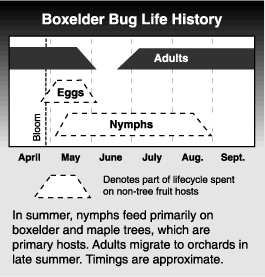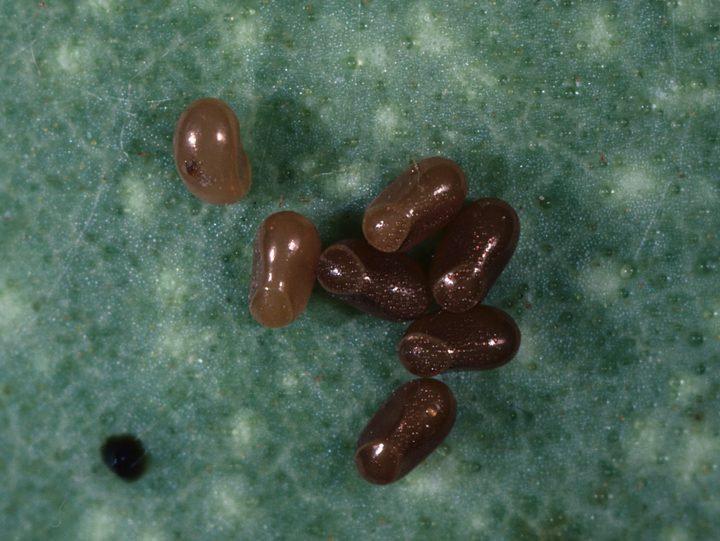by E.W. Anthon, originally published 1993
Leptocoris rubrolineatus Barber (Hemiptera: Rhopalidae)
The western boxelder bug is a sporadic, and usually minor, orchard pest found throughout western North America. It reproduces on maple and boxelder trees but may migrate in large numbers to orchards during late summer. It is occasionally a household pest. When populations are high they will move to buildings from nearby host trees.
Hosts
The western boxelder bug’s primary host is boxelder. There are two types of boxelder trees, those that bear seeds and those that do not. The boxelder bug lives mostly on the seed bearing type. It also feeds on the foliage of maple, ash, alfalfa and potatoes, and will attack fruit on apples, pears, cherries, peaches and plums.
Life stages
Eggs
Eggs are small, rusty red and are laid in groups of two or three.
Nymph
The young nymph is bright red and becomes marked with black when about half grown.
Adult
The adult is flat, elongated and 3/8 to 5/8 inch (10 to 14 mm) long. It is gray-brown to black with conspicuous red lines on the thorax and wing coverings. The body beneath the wings is dark orange, which makes it easy to spot in flight. The head and antennae are black.
Life history
 Adults hibernate during the winter in crevices of trees and buildings. They may appear in swarms on sunny winter days. In spring, females lay eggs in cracks in tree bark. Eggs hatch in 10 to 14 days. Nymphs feed on flowers, fruits, foliage and tender twigs. Adults may migrate to orchards in late summer, shortly before fruit matures. There is one generation each year in the Northwest.
Adults hibernate during the winter in crevices of trees and buildings. They may appear in swarms on sunny winter days. In spring, females lay eggs in cracks in tree bark. Eggs hatch in 10 to 14 days. Nymphs feed on flowers, fruits, foliage and tender twigs. Adults may migrate to orchards in late summer, shortly before fruit matures. There is one generation each year in the Northwest.
Damage
Adults suck juices from fruit as they feed, causing dimples and deformations. The flesh of fruit where the bug has fed is corky and white. The damage looks similar to late season stink bug damage.
Monitoring
Potential damage in orchards cannot be determined by monitoring populations on host plants. Large numbers of western boxelder bugs may be found, but they do not always move into orchards and feed on fruit. A beating tray can be used to monitor adults in the orchard. However, this is not a practical method in late summer because too many fruit are dislodged. Visual observations are probably the best method. Adults are very easy to detect if they are in the orchard in large numbers.
Management

Problems with western boxelder bug are sporadic but can be persistent and annual in some locations. Most orchards are not threatened by this pest. When populations are high on native hosts that dry out in late summer, adults will migrate in large numbers to orchards in search of food. Many insecticides will kill adults, but repeated applications may be required to protect fruit if they continue to immigrate from outside sources. Removal of hosts plants near the orchard may help reduce problems in orchards that suffer annual damage.


